
Genoplesium nigricans, commonly known as mallee midge orchid, is a species of orchid endemic to Australia. It is a terrestrial herb with a single leaf mostly surrounding the stem, and up to 50 tiny, greenish flowers with a deep maroon-coloured labellum and often have a fruity fragrance. Australian authorities use the name Corunastylis tepperi, a widespread species which has been confused with Corunastylis nigricans, a species with purplish brown flowers and which only occurs on Kangaroo Island and the Eyre Peninsula.
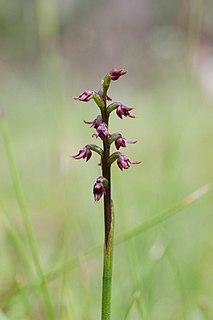
Genoplesium nudum, commonly known as the tiny midge orchid in Australia or the red midge orchid in New Zealand, is a small terrestrial orchid native to south-eastern Australia and New Zealand. It has a single thin leaf fused to the flowering stem and up to forty small, reddish-purple or green and red flowers. Australian and New Zealand authorities use the name Corunastylis nuda but Genoplesium nudum and Prasophyllum transversum are used by the World Checklist of Selected Plant Families.
Genoplesium nudiscapum, commonly known as the bare midge orchid, is a species of small terrestrial orchid endemic to Tasmania. It has a single thin leaf fused to the flowering stem and up to twenty small, green and reddish-brown flowers. It was thought to be extinct, since it had not been seen since 1852 but was rediscovered in 2008. The species has also been described as occurring on continental Australia. The species is known as Corunastylis nudiscapa in Tasmania.
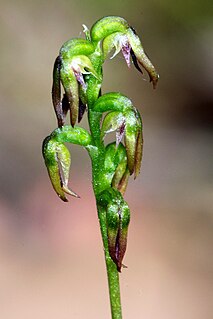
Genoplesium despectans, commonly known as the sharp midge orchid and known as Corunastylis despectans in Australia, is a small terrestrial orchid endemic to south-eastern Australia. It has a single thin leaf fused to the flowering stem and up to forty five small, dark purple or green and purple flowers.

Genoplesium morrisii, commonly known as the bearded midge orchid and known as Corunastylis morrisii in Australia, is a small terrestrial orchid endemic to south-eastern Australia. It has a single thin leaf fused to the flowering stem and up to fifteen small, dark purplish-black or green and purple flowers.
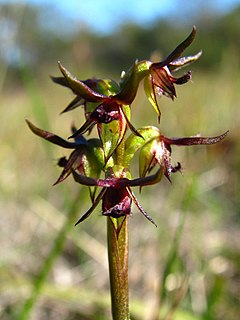
Genoplesium archeri, commonly known as the elfin midge orchid and as Corunastylis archeri in Australia, is a small terrestrial orchid endemic to south-eastern Australia. It has a single thin leaf fused to the flowering stem and up to fifteen small, hairy, yellowish green flowers with purple stripes. It grows in a wide range of habitats in New South Wales, Victoria and Tasmania.
Genoplesium citriodorum, commonly known as the lemon-scented midge orchid is a species of small terrestrial orchid that is endemic to New South Wales. It has a single thin leaf fused to the flowering stem and up to thirty three small, lemon scented, dark purplish black flowers. It usually grows under shrubs in shallow sandstone soil in the Blue Mountains.
Corunastylis capparina is a small terrestrial orchid endemic to Victoria. It is one of the midge orchids and has a single thin leaf fused to the flowering stem and up to twenty small, green flowers with purple markings. It is a rare species, found only in a small area in the south-east of the state.
Genoplesium insigne, commonly known as the dark midge orchid or Wyong midge orchid is a species of small terrestrial orchid that is endemic to New South Wales. It has a single thin leaf and up to twelve dark purple to dark reddish purple flowers. It is mostly found in heath on the Central Coast and only around fifty plants survive.
Genoplesium morinum, commonly known as the mulberry midge orchid, is a species of small terrestrial orchid that is endemic to New South Wales. It has a single thin leaf fused to the flowering stem and up to twenty crowded, dark reddish purple flowers. It has been known as "mulberries on sticks".
Genoplesium pedersonii, commonly known as Pederson's midge orchid, is a species of small terrestrial orchid endemic to the Blackdown Tableland in Queensland. It has a single thin leaf fused to the flowering stem and up to thirty small, greenish red to reddish, self-pollinating flowers with a dark purplish red labellum. The species is treated as Corunastylis pedersonii in Queensland.
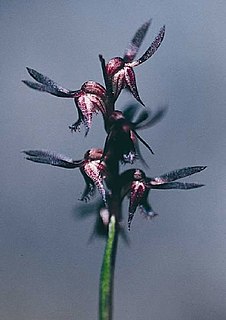
Genoplesium rhyoliticum, commonly known as the Pambula midge-orchid or rhyolite midge orchid and as Corunastylis rhyolitica in Australia, is a species of orchid endemic to New South Wales. It is a small orchid with up to eighteen dark, purplish-black flowers and is only known from six sites on the south coast where it grows in shallow soil over rhyolite.
Genoplesium sigmoideum, commonly known as the Dave's Creek midge orchid, is a species of small terrestrial orchid that is endemic to a small area in the Lamington National Park in Queensland. It has a single thin leaf fused to the flowering stem and up to twenty dark red flowers with a hairy labellum. The species is treated as Corunastylis sigmoidea in Queensland.
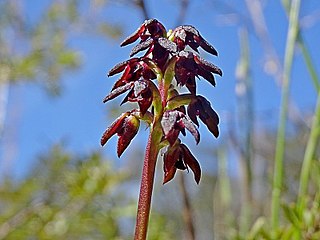
Genoplesium vernale, commonly known as the spring midge orchid or East Lynne midge orchid is a small terrestrial orchid which is endemic to a small area on the south coast of New South Wales. It has a single thin leaf and up to twenty five dark purplish-black flowers with tiny glandular hairs on the sepals and petals.
Genoplesium simulans, commonly known as the Blue Mountains midge orchid is a small terrestrial orchid which is endemic to New South Wales, where it mainly occurs in the Blue Mountains. It has a single thin leaf and up to twenty three dark purplish-black flowers which lean downwards.
Genoplesium superbum, commonly known as the pink midge orchid or superb midge orchid, is a species of small terrestrial orchid that is endemic to New South Wales. It has a single thin leaf and up to fifteen dark pinkish-purple flowers which lean downwards. It is listed as "endangered" in New South Wales because of its limited distribution and disturbance of its habitat.
Genoplesium superbum, commonly known as the Kangarooby midge orchid, is a species of small terrestrial orchid that is endemic to New South Wales. It has a single thin leaf and up to thirty two hairy, light reddish flowers which lean downwards and have a dark purple labellum.
Genoplesium tectum, commonly known as the Cardwell midge orchid, is a small terrestrial orchid endemic to a small area in north-eastern Queensland. It has a single thin leaf fused to the flowering stem and up to thirty light red flowers with a dark reddish-black, hairy labellum.
Genoplesium turfosum, commonly known as the alpine midge orchid, is a small terrestrial orchid endemic to a small area in the higher parts of New South Wales. It has a single thin leaf fused to the flowering stem and up to twenty five dark purplish-red, crowded flowers with a sparsely hairy labellum.
Genoplesium validum, commonly known as the Blackdown midge orchid, is a species of small terrestrial orchid that is endemic to the Blackdown Tableland National Park in Queensland. It has a single thin leaf fused to the flowering stem and up to thirty five greenish-brown flowers with reddish stripes and a hairy labellum. This species is treated as Corunastylis valida in Queensland.






